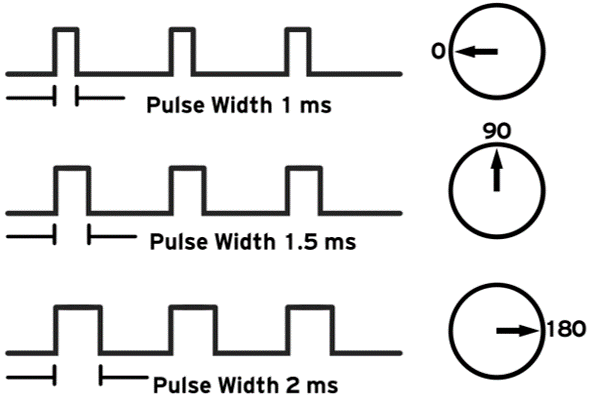Servo Motors
Background
.jpg)

A servo motor is a special type of motor with internal electronics for control. It can rotate 180 degrees and is controlled using a single wire to tell it the position it should be in. A 50 Hz pulse signal is sent on the line with a varying on-time between 1 and 2 milliseconds corresponding to specific positions of the motor. The motors provided in your kit can move at a rate of 60 degrees in 0.1 seconds. They are typically powered from an external source (not the Arduino's 5V power supply).
Hardware Description

Pinout
- Brown - Ground
- Red - 5V (connected to an external power supply, not the Arduino's 5V supply)
- Orange - Pulse Signal - connected to a digital pin as output
Note: If you are using more than one servo or a larger servo, you must use an external power supply to provide 5V to the motor. Make sure to connect the ground between the Arduino board and the power supply, so they have a common reference.
Software Description
This library allows an Arduino board to control hobby servo motors. The Servo library supports up to 12 motors on most Arduino boards. On the Arduino Uno, the library disables analogWrite() PWM functionality on pins 9 and 10, whether or not there is a Servo on those pins.
#include <Servo.h>- Include the servo library.
Servo myservo;
- Declares servo object. Must create a unique name similar to variables.
- Can declare multiple servos. Use the unique name to refer to it and control using the methods (special function you can call on object) below.
myservo.attach(pin);- Define what pin the servo is attached to.
myservo.write(pos);- Set the new angle value for the servo.
- Must provide a value between 0 & 180.
myservo.read();- Returns the angle value that was last written to the servo.
https://create.arduino.cc/editor/mjdargen_ncsu/141a1d00-9c5f-45e9-9924-3b218bf70ade/preview
More Advanced Control
If you want to better control the speed that your servo moves, you can use a function I wrote entitled my_servo_write.
my_servo_write(&servo, pos, speed)- function to easily move servo controlling the speed and the rotation.
&servo- pointer to servo object to be controlled.
- Provide the name of the servo object you declared.
- Must use an ampersand (&) in front of servo name.
pos- position you would like to move the servo to.
- The position is an angle, so any value between 0-180.
speed- how many milliseconds per degree.
- Can't move faster than 2 ms per degree.
- Typically range from 2 (fast) to 25 (slow).
Exp: my_servo_write(&myservo, 180, 2);
- Move servo that was named “myservo” to position angle “180” at the fastest speed of “2” ms per degree.
- my_servo_write Function: https://gist.github.com/mjdargen/0e460527229f88e4e21344a168edc94b
https://create.arduino.cc/editor/mjdargen_ncsu/2f2d095b-9fb3-4f3b-8ee2-45dd15c3914c/preview